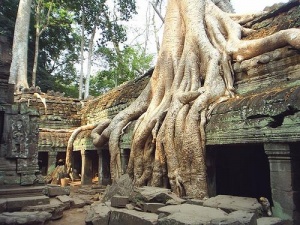Ta Prohm
From The Art and Popular Culture Encyclopedia

|
Related e |
|
Featured: |
Ta Prohm is the modern name of a temple at Angkor, Cambodia, built in the Bayon style largely in the late 12th and early 13th centuries and originally called Rajavihara. Located approximately one kilometre east of Angkor Thom and on the southern edge of the East Baray near Tonle Bati, it was founded by the Khmer King Jayavarman VII as a Mahayana Buddhist monastery and university. Unlike most Angkorian temples, Ta Prohm has been left in much the same condition in which it was found: the photogenic and atmospheric combination of trees growing out of the ruins and the jungle surroundings have made it one of Angkor's most popular temples with visitors.
Silk cottonwood and strangler fig trees
The trees growing out of the ruins are perhaps the most distinctive feature of Ta Prohm, and "have prompted more writers to descriptive excess than any other feature of Angkor." Two species predominate: the larger is the silk-cotton tree (Ceiba pentandra), and the smaller is the strangler fig (Ficus gibbosa). Indulging in what might be regarded as "descriptive excess," Angkor scholar Maurice Glaize observed, "On every side, in fantastic over-scale, the trunks of the silk-cotton trees soar skywards under a shadowy green canopy, their long spreading skirts trailing the ground and their endless roots coiling more like reptiles than plants."
See roots of a Tetrameles nudiflora in Ta Prohm.

